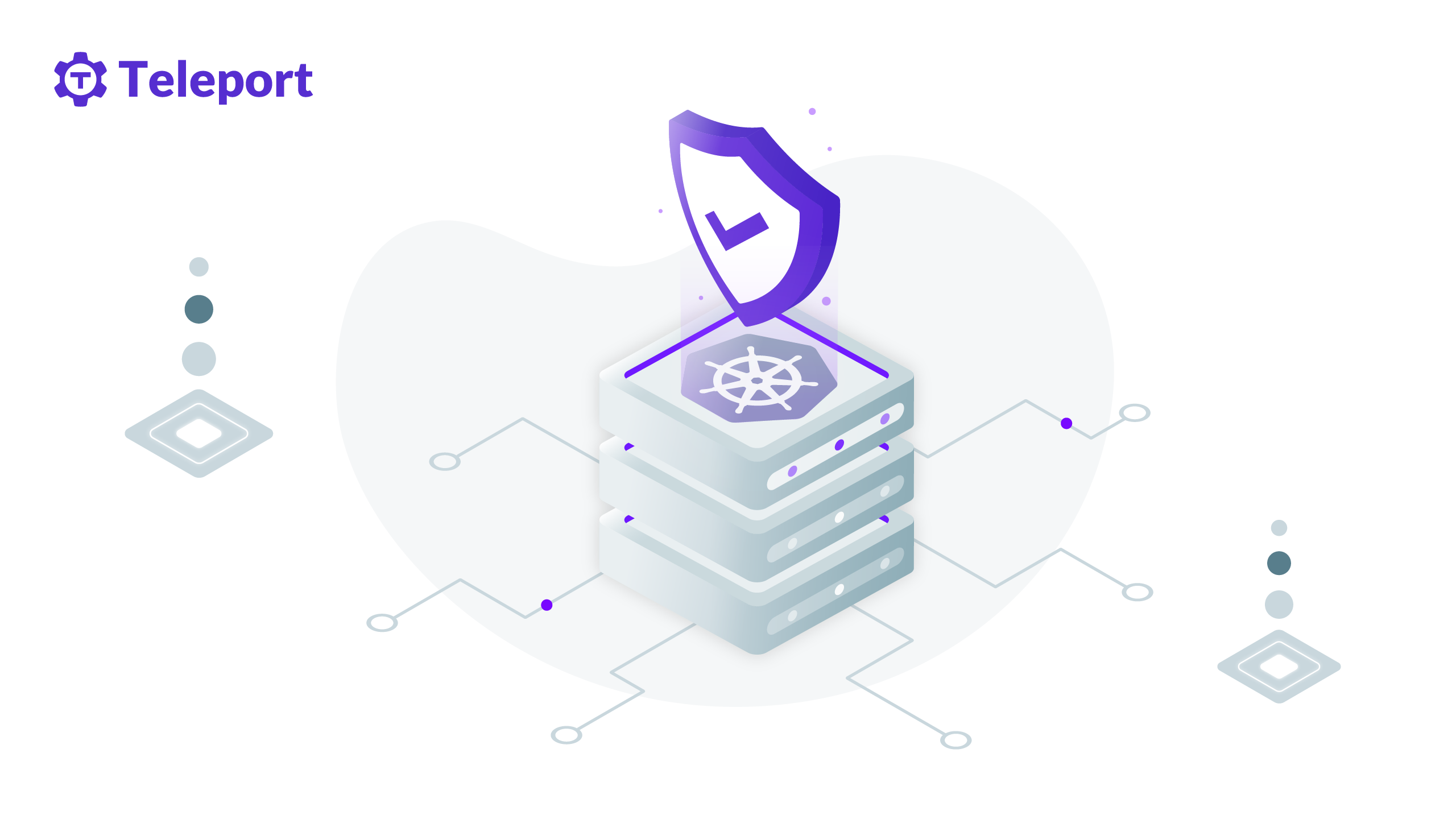Teleport Blog - How to Hack Kubernetes (and How to Protect It) - Mar 8, 2022
How to Hack Kubernetes (and How to Protect It)

Kubernetes is a valuable resource and a leading container management system in development pipelines across the world, but it’s not exempt from malicious attacks. Using Kubernetes requires a deep understanding of Kubernetes’ environment—including the different vulnerabilities you can be exposed to while creating, deploying, or running applications in your clusters.
Since your Kubernetes cluster is likely one of your most valuable cloud resources, it needs to be protected. Kubernetes’ security addresses the safety of your cloud, application clusters, containers, apps and code. Although Kubernetes provides inherent security advantages, bolstering your defensive tactics is crucial to protecting your system against hackers and other cybersecurity threats.
This roundup covers the top seven ways your cluster is likely to be attacked, with a corresponding countermeasure for each.
Why do you need defense tactics to avoid getting hacked?
Because of the distributed, dynamic nature of a Kubernetes cluster, you need to implement defensive tactics that follow the best security practices throughout the container lifecycle.
While several security issues exist with Kubernetes throughout the application lifecycle (build, deploy, and runtime), some of the most critical security concerns include:
-
Using codes from unverified open source public registries: This can create backdoors for threat actors to exploit — giving them access to your critical assets. To protect the software supply chain from malware.
-
Failing to follow the principle of least privilege (PoLP): PoLP ensures you limit the privileges that users have access to. According to the CISA, if a subject doesn’t need an access right, the subject should not have that right. Granting unnecessary privileges widens the attack surface and creates more security loopholes for attackers to pounce on.
-
Building complex Kubernetes clusters: This makes it difficult to isolate and replace compromised clusters when there’s an attack, hampering the remediation process. Therefore, developing adequate defense strategies is key to keeping your clusters protected from bad actors and misconfigurations at all times.
The top seven defense tactics for protecting your Kubernetes clusters
While Kubernetes enables some essential security measures by default, developers must explore the best security practices to ensure the safety of their clusters.
The defense tactics in this article were selected based on industry standard best practices for preventing a Kubernetes hack. It includes comments made by several experts to explain how and why these strategies will help to secure Kubernetes workloads and mitigate cloud environment risk.
1. ABAC vs. RBAC
While attribute-based access control (ABAC) is a great access control method, it’s complex to understand and manage. Apart from its complexity, ABAC grants access rights to users based on user attributes like subject attributes, resource attributes, and environmental attributes. ABAC enables cluster-wide permission for users to do whatever they want: create resources in the cluster, view secrets, delete codes and more. It doesn’t ensure maximum protection and can have catastrophic consequences.
Kubernetes announced the release of Kubernetes 1.6 on March, 28, 2017, stating that “Role-based access control (RBAC), kubefed, kubeadm, and other scheduling features were moving to beta.” Moving RBAC to beta was a major highlight of this announcement. Andrew Grant, co-founder of Control Plane and coauthor of Hacking Kubernetes, noted in an article that ABAC has been superseded by RBAC since release 1.6, and that it should not be used on the API server.
According to Grant, disabling ABAC and enabling RBAC with least privilege offer powerful protection against getting hacked. Unlike ABAC, RBAC grants access rights to users based on their roles. For example, while a DevOps team may have access to programming files, a project management team will have access to all the project files. That’s an example of what RBAC does — enabling permissions based on the functions of users.
You can enable RBAC by starting the kube-apiserver with the --authorization-mode flag:
kube-apiserver --authorization-mode=Example,RBAC --other-options --more-options
More details on RBAC can be found in the Kubernetes documentation and Kubernetes API Access Hardening.
2. Monitor the logs
Another way to prevent your clusters being hacked is to ensure that you monitor logs and audit them regularly for suspicious activities like unusual or unwanted API calls—especially authentication failures. Although audit logging helps with analysis and identifying trends over time, notes Amir Kaushansky, VP of Products at Armo, it’s most commonly used by organizations to monitor Kubernetes cluster performance and enforce security.
For example, if a log entry displays a message status like “Forbidden,” which was not authorized by a cluster administrator, it could mean that an attacker is trying to use stolen credentials. Kubernetes users can access this data in their console and set up notifications for authorization failures.
Audit logging enables customizable event logging. You can set one of the four API logging levels:
- None
- Metadata only
- Request: this logs metadata and requests but not responses
- RequestResponse: logs metadata, requests, and responses
Note: Keeping these logs inside clusters poses a security threat, as compromise on a sector of any cluster might provide hackers with the logs stored in that cluster and jeopardize the overall security of your clusters. Any sensitive logs should be transported outside the cluster to mitigate risk.
To enable audit logging, you need to use the --audit-policy-file flag while starting kube-apiserver. The policy file contains the rules
which dictate what will be logged. Here’s an example policy template file:
apiVersion: audit.k8s.io/v1
kind: Policy
# Ignore all requests in RequestReceived stage.
omitStages:
- "RequestReceived"
rules:
# Log pod changes at RequestResponse level
- level: RequestResponse
resources:
- group: ""
resources: ["pods"]
3. Rotate encryption keys regularly
One of the best security practices to protect your Kubernetes against malicious actors is regularly rotating encryption keys and certificates. By default, these certificates are issued with a year-long expiration date so that you don’t have to renew them frequently. However, you can also customize them to a time more suitable for you.
Kubernetes enables encryption keys and certificate rotation to automatically generate a new key and request a new certificate from the API server as the current certificate approaches expiration. Once the new certificate is available, it will authenticate connections to the Kubernetes API. This process saves time by ensuring the user doesn’t need to frequently rotate keys and certificates.
In addition, it’s essential to always encrypt your backups using a well-reviewed backup encryption solution, and consider using full disk encryption where possible.
Rotating encryption keys and certificates regularly limits the damage in the event of a key compromise. Thankfully, Kubernetes’ automated process of changing keys and certificates removes the possibility of human failure: a leak of sensitive keys.
If you want to see how to rotate etcd encryption keys in Kubernetes, you can check out this article.
4. Update your Kubernetes version
As simple as it may seem, keeping Kubernetes up to date is an excellent way to keep clusters safe from attacks. To get a sense of how secure your current version is, you can find a list of Kubernetes vulnerabilities on this CVE list.
For developers who use a hosted provider such as AWS EKS, check if your provider automatically updates your Kubernetes version.
5. Whitelist application processes
Process whitelisting helps to identify processes that run unexpectedly.
The first step to using process whitelisting to protect Kubernetes is to observe and identify every process that runs when an application behaves normally. Next, use this list as a whitelist to check for any anomalies in future application behaviors.
If a hacker manages to access your cluster and runs harmful processes, the whitelist helps you to swiftly identify and flag such irregularities.
6. Run containers as a non-root user
Running containers as a root user exposes you to security breaches. As tech columnist Raquel Campuzano Godoy puts it on
Bitnami,
“Anyone who accesses your container running as root can start undesirable processes in it — such as injecting malicious codes”. Running
your docker containers as a root user also makes your applications vulnerable because it enables users to change the user ID or group ID
when they start the container.
Reconfiguring your containers from root to non-root provides an additional layer of protection that secures you against hackers. A
selection of non-root image containers tagged “non-root” is available here on Bitnami’s GitHub
repository.
To run a container as a non-root, you need to set the securitycontext field to specify exactly what permissions the container should
have. In this context, you need to set the securitycontext.runAsUser and securityContext.runAsGroup to run containers as a non-root
user.
Here is how to configure a security context for a pod or container.
7. Audit kubectl usage
Integrating Kubernetes with a third-party authentication provider like Teleport is another effective way to
protect your clusters against threat actors. It provides additional security features such as multi-factor authentication and ensures there
are no changes to the kube-api server when users are added or removed.
Teleport offers an identity-based access proxy for multiple Kubernetes clusters. User certificates are issued after their identities are validated by single sign-on (SSO) providers such as Okta, GitHub, Google Apps, and others. Teleport Kubernetes Access offers a simple, unified way to access all environments via a single access point, using the same identity provider. This provides the same role-based access (RBAC) rules for all your Kubernetes clusters and resources — ensuring secure access to them.
Teleport delivers hardened security best practices to companies. Use it to:
- Secure your Kubernetes clusters while meeting compliance requirements
- Secure access to underlying linux infrastructure
- Prevent honeypot attacks and eliminate the issue of trust on first use
- Allow users to enumerate all servers and other current online resources
- Improve visibility into access and behavior across your infrastructure
- Full playback for
kubectl execs - Reduce the operational overhead of enforcing security best practices
Conclusion
While many DevOps teams enable default security measures that come with Kubernetes, these measures aren’t enough to keep clusters protected from attacks. Vigilant DevOps teams need to do more to create the walls necessary to stop hackers from infiltrating their systems.
This post scratches the surface of Kubernetes-based attacks. If you would like to learn more, I would recommend checking out Episode 8 of Access Control on Securing Kubernetes. The CIS has a great benchmark for securing Kubernetes and if you want to up level your cloud native skill set, we would recommend the CNCF (Certified Kubernetes Security Specialist (CKS) exam)[https://www.cncf.io/certification/cks/].
Tags
Teleport Newsletter
Stay up-to-date with the newest Teleport releases by subscribing to our monthly updates.

Subscribe to our newsletter

